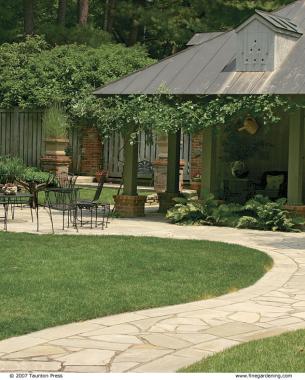
Would you believe me if I told you that your choice of paving material could be the single most important decision in building your garden? Think about it: You may occasionally touch a plant, hold open a gate, or relax on a piece of garden furniture, but your feet are almost always in contact with your garden’s surface. Like plants, paving materials can add color, texture, and pattern to your garden. Unlike plants, which grow, bloom, and often go dormant as the seasons change, paved surfaces contribute in equal measure throughout the year.
The most widely available paving materials fall into two broad categories: quarried stone and composite material. Quarried stone, such as granite and slate, is dug and then shaped by splitting, cutting, or crushing. Composite materials like brick and precast concrete pavers are processed and molded when soft, then fired or allowed to dry.
The great range of paving materials makes shopping and designing fun, but the number of choices can also be a bit overwhelming. Each one has its advantages and disadvantages, and some are better suited than others to particular uses and locations. By understanding and exploring your options, you’ll be able to make the right choice for your setting and budget.
Note: Cost ranges given are averages for raw materials before installation from suppliers found throughout the United States. Expect some variability from region to region. The costs ranges are based on 2007 prices, but can still be used for relative comparisons of the various materials.
Stone
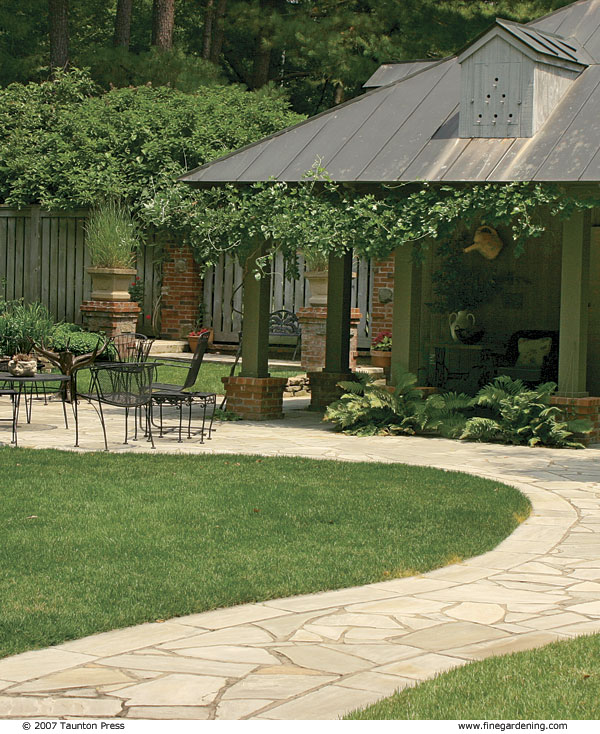
Photo/Illustration: Jennifer Benner
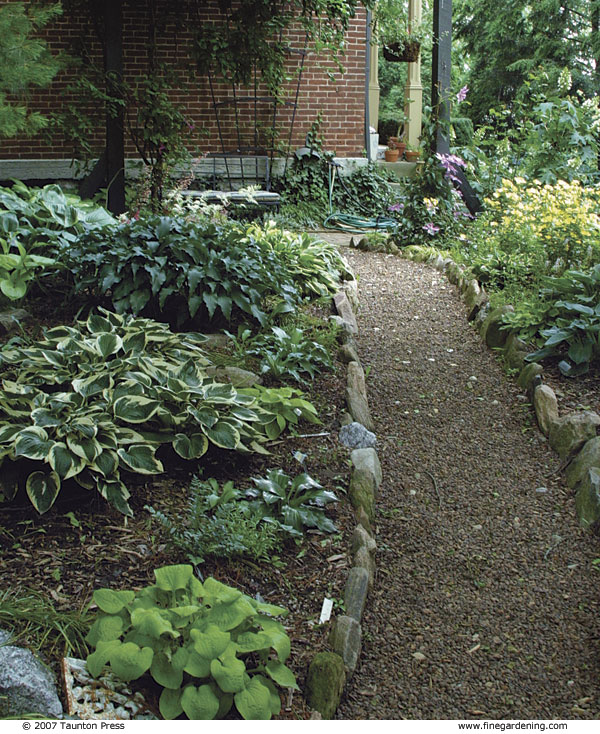
Photo/Illustration: Jennifer Benner
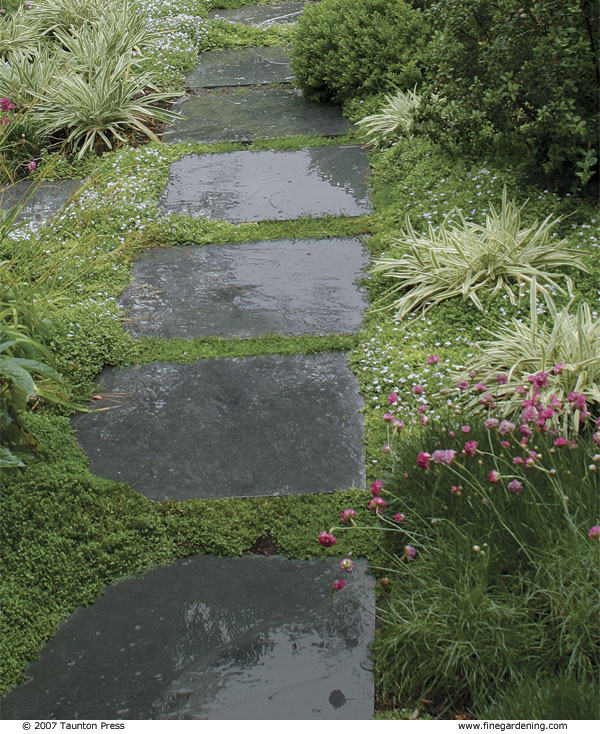
Slate Pros• Attractive• Easy to shape Cons• Susceptible to extreme moisture damage Cost• $4 to $7 per square foot
Photo/Illustration: Janet M. Jemmott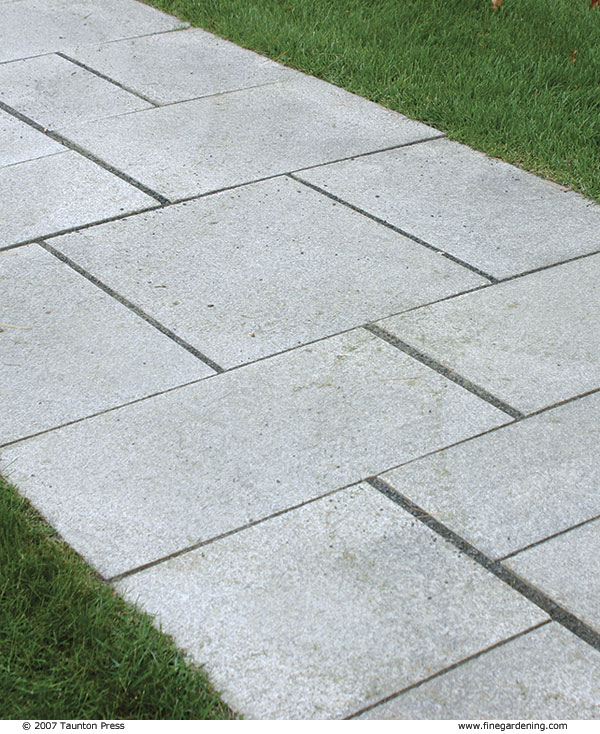
Granite Pros• Durable• Huge color range Cons• Difficult to work with• Expensive Cost• $8 to $20 per square foot
Photo/Illustration: Jennifer Benner
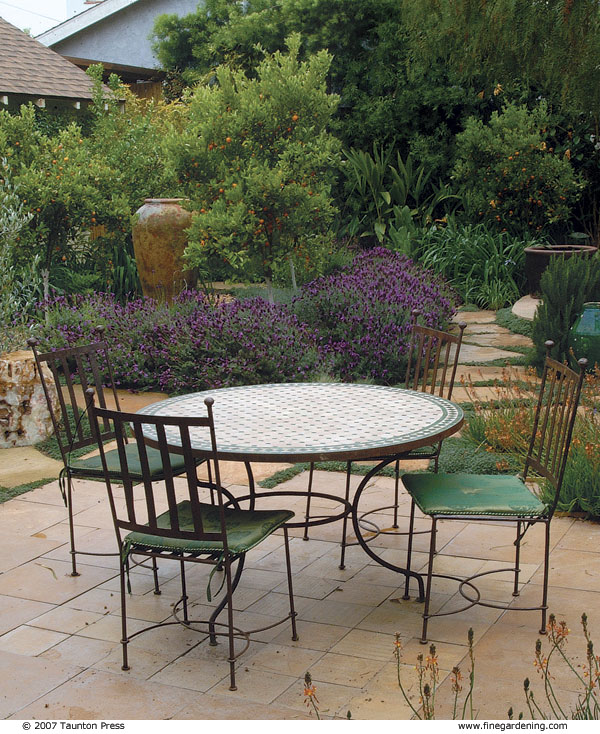
Photo/Illustration: Todd Meier
Stone is among the most nuanced and luxurious of paving materials. It’s also durable and versatile, offering an enormous range of colors, shapes, and sizes. From irregularly shaped flagstones for country-garden paths to precision-cut geometric blocks for a formal patio, there is a stone for every garden situation. All of this, however, comes at a price. Stone can be expensive to purchase and install. Paving-stone availability and prices vary from region to region, depending on the quantity purchased and your distance from the source.
There are a few points to keep in mind when purchasing stone for paving. A thickness of at least 2 inches is best for supporting frequent foot traffic and enduring the vagaries of settling or weather. Avoid rounded cobblestones, and flagstones with a polished or honed finish, which can be hard on the ankles and slick when wet. Instead, choose stones that are flat and have a natural-cleft surface and offer some grip or texture.
Before making a costly commitment to any material, check its color when wet. That pretty honey-tan granite you like so much could turn a lurid golden orange in the rain. Likewise, a subtle pattern in your sandstone may become objectionably bold when accentuated by moisture.
Sandstone is an excellent all-around choice
One of the most popular stones for garden paving is sandstone. It is tough enough for any paving application but is easier to cut and work than granite, which helps account for its lower cost. Sold under descriptive names like “Crab Orchard” (photo, below), “Colorado Red,” and “Pennsylvania Blue,” sandstone is available in many shapes and colors and is easy to come by in large quantities. Blue-gray and lilac-gray are common sandstone colors, but light gray, tan, soft golden cream, and orange-brown can be found as well. Expect some color variation in every lot of sandstone, along with occasional bands or blotches of contrasting color in each piece.
Gravel is a great option for a small budget
Gravel is easy to install and provides an attractive texture ideal for informal landscapes, short-term paving solutions, and gardens built on limited budgets. The objections usually raised against gravel is that it can become weedy and it’s too unstable underfoot. Weeds can become a problem if gravel is left untended, so it’s best to stay on top of them. To avoid issues with footing, select gravel that is labeled “1/4 inch minus”; anything larger is liable to shift noticeably. Avoid rounded, tumbled pea gravel as well. Sharp, angular, unsorted gravel will interlock as it settles to form a firm surface that will not spill, furrow, or shift. It also helps to tamp or compact the gravel, which should be done after a 2- to 3-inch-deep layer is put down.
Slate stands out for its texture and color
Often used as a flagstone, slate has a unique soft texture and subtle color palette that visually draws people in like a magnet. Its pastel blue-grays to muted reds and lavenders are beautiful, both to look at and to walk on. The same quality that makes slate easy to shape into relatively flat pieces can also limit this stone’s durability as an outdoor paving material. In areas that experience heavy rainfall or freeze/thaw cycles, slate will often flake and chip. The resulting uneven surface can puddle in wet weather, freeze over in winter, and trip up garden visitors in any season. Slate holds up best in relatively sheltered locations or regions with limited rainfall and mild climates.
Granite can’t be beat for strength and durability
For sheer durability, nothing can trump granite. It makes an elegant paving material for formal outdoor spaces and is often sold as cubes or brick-shaped pieces called sets (or setts) or as uniform-size (dimensional) flagstone. Besides its hardness and durability, granite offers what may be the widest color choice of all paving stones. From light through dark gray to grayish blue, tan, brown, honey yellow, green, orange, pink, and red—with or without conspicuous spots and blotches—the range seems almost infinite. The same hardness that makes granite so lasting also makes it relatively difficult to quarry and work, so it’s usually among the pricier paving stones. Because of the relatively high price, gardeners often use colorful granite sets as accents for more economical paving, as either inset patterns or decorative edges.
Limestone adds a distinctive look to paths and patios
Limestone is fine textured, so it takes on a distinctive, velvety finish when cut for paving. Its color range is a bit more limited than granite or sandstone. Dark gray, blue-gray, pale gray, cream, and tan are usually the easiest to find. Limestone tends to be more evenly colored than sandstone or granite, and its very fine grain makes it relatively easy to cut into all sorts of decorative shapes.
Limestone is uncommon in some parts of North America, including the Pacific Northwest and California coast, so you can expect its price to be close to that of sandstone or granite, depending on where you live. A word of caution about limestone: Its chemistry makes it susceptible to damage from acid rain, which can cause pitting and promote excessive wear over time. I wouldn’t worry too much, though, unless you live in an area with a serious acid-rain problem.
Glossary
As with any specialty, the paving industry has its own jargon. While the meaning of these terms is common knowledge among professionals, they can seem bewildering to the average person. Here is a list of frequently used expressions, which are handy to know.
Cleavage: the point where stone will naturally split or separate
Cleft: the natural surface of a split or “cleaved” stone that has not been finished or honed
Cobblestone: natural, rounded stone used for paving
Dimensional stone: precision-cut flagstone milled to a specific size and shape (square, rectangle)
Fieldstone: a found stone that is naturally split and weathered and comes in a variety of shapes and sizes
Flagstone: a stone milled or cut to a thin size
Pavers or sets: any stone or composite milled into a uniform shape, like a brick or granite Belgian block
Stone dust or powder: finely graded, crushed-stone particles commonly used as the subsurface or bedding material for stone and composites
Try mixing and matching materials
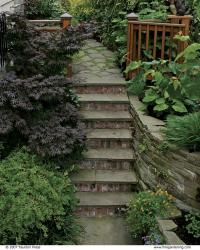
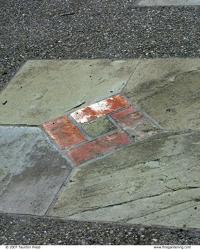

For a change of pace, try mixing materials to develop your own unique and exciting designs. A medley of paving materials provides a range of patterns and textures beyond anything you could accomplish with a single type of stone or composite. Something as simple as a brick or granite border can be used to dress up a poured-concrete walk. Or consider using different shades of the same type of stone to turn a common walkway into a dynamic focal point.
Use splashes of various materials to beautify and break up expansive areas. A row of brick-and-stone insets can easily transform a poured-concrete driveway from a potential eyesore to a showstopper. Even gravel can be elevated to new heights by adding flagstones or precast concrete accents.
Mixed paving can be more than just decorative; it has important practical applications, as well. A different paving material or contrasting border can alert visitors to elevation changes in the garden. Multilevel patios in contrasting colors of stone and concrete are not only attractive but also easy to navigate. Using one paving material for patios and another for walkways also distinguishes gathering places from transit ways.
To avoid a busy appearance, I like to limit myself to two or three paving materials in small spaces, adding perhaps a fourth in large settings. Don’t feel bound, however, by such rules of thumb. I have seen magnificent small patios that feature elaborate, abstract mosaics of at least half a dozen different kinds of stone.
Composite
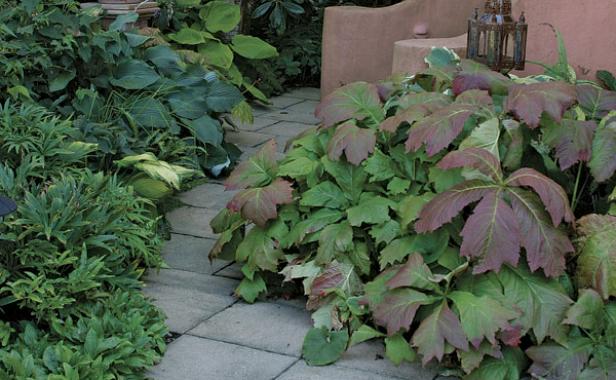
Photo/Illustration: Jennifer Benner
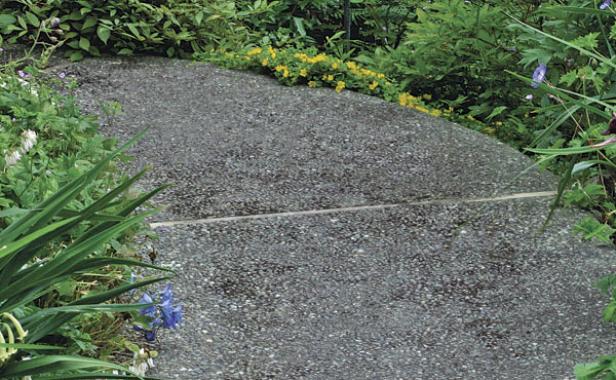
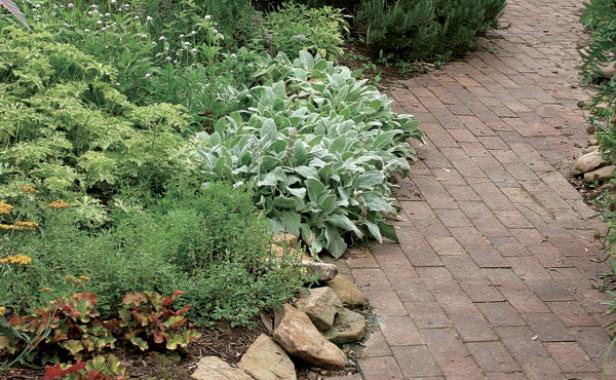
Photo/Illustration: Jennifer Benner
As paving materials, composites can offer a greater degree of flexibility and a wider range of prices than quarried stone. Being molded to set dimensions, precast composite materials are often easier to install than stone. One of them, poured concrete, can even take on forms that are virtually impossible to build in stone or precast composites. Like quarried materials, composites offer a broad range of colors, textures, and styles.
Whatever your choice of paving material, it’s wise to consider the color, texture, and style of the surrounding plants and structures. Make certain you like the way your pavement looks next to your home, fence, garden walls, and plants and with any furnishings you’ll be using. The best method is to borrow or purchase a small amount of paving material and bring it to your garden. Look at it in different lighting, positions, and times of day before you commit. Paving is not only expensive to install and remove but also liable to be the most lasting and influential element in your garden.
Concrete pavers won’t break the bank.
Once frowned upon by designers for their clumsy attempts at simulating brick or stone, molded concrete pavers are now recognized for their high quality. Whether proudly proclaiming their true concrete nature with attractive aggregate and subtle pigments or masquerading slyly as stone or brick, precast concrete pavers can reward gardeners with more textural effects and colors than any other material. Pavers also come in many shapes and sizes that hold up well over time.
Poured concrete offers lots of flexibility and options.
Poured concrete, especially when reinforced and provided with expansion joints, is one of the toughest and most permanent paving options. It’s also one of the most flexible. Concrete can assume almost any shape imaginable, and its appearance can vary with your choice of aggregate and pigments. Exposed aggregate concrete can look much like gravel paving, and poured concrete of all kinds can be sculpted, textured, or inlaid with other materials to suit any design or taste. If you choose to tint your concrete, make sure you see a dry sample of the mix (preferably with the same aggregate you’re using) before your paving is poured. Pigments can alter dramatically once concrete hardens, and any mistakes will be difficult to correct. The cost of poured concrete is more variable than other paving materials because so much of the ultimate expense is tied up in building the forms that dictate its final shape. The concrete itself is not usually expensive, but labor, trucking, and installation can add up quickly.
Brick is at home in any setting
Brick may be the aristocrat of composite paving materials, but when it comes to garden applications, it’s no snob. Depending on the type and the pattern you choose, brick can be equally at home in a cottage garden or a grand estate. With its warm hues and inviting texture, brick harmonizes well with plants and with almost any other paving or building material. Its handy size and uniform shape make it relatively easy to design with and install, and it’s available almost anywhere. Bricks vary in their strength and resistance to the elements, so confirm that your choice is rated for use in paving. Along with stone, brick ranks among the costlier paving materials. Even salvaged bricks, which were once an economical alternative to new material, have become so popular in some areas that they’re no longer a bargain.

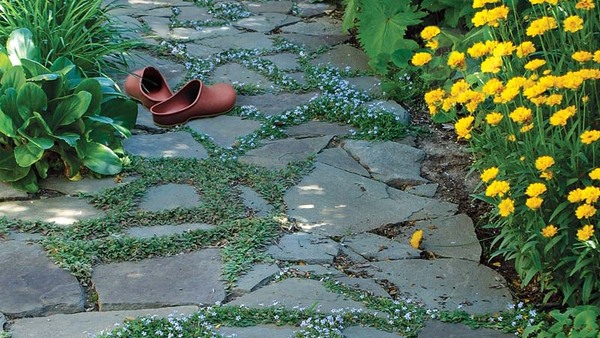
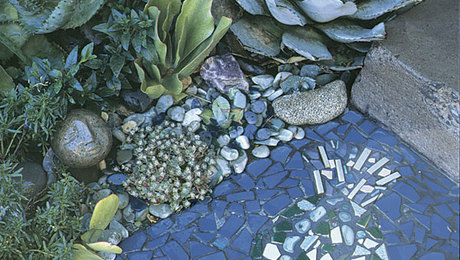
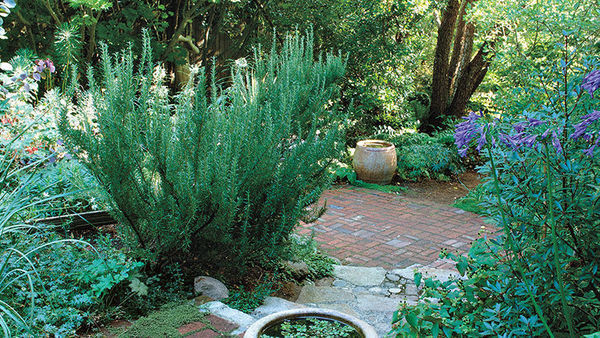













Comments
Log in or create an account to post a comment.
Sign up Log in